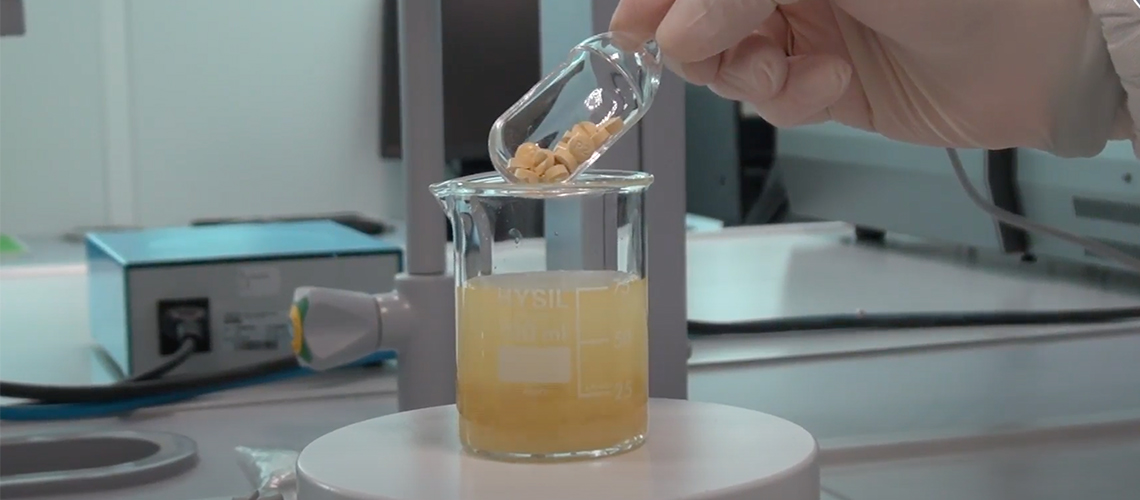Gel formulations for oral administration of drugs, in particular to dysphagic patients
UniCam – Area ricerca trasferimento tecnologico e gestione progetti
Field of application
La presente invenzione ha lo scopo di sviluppare un metodo efficace per riformulare compresse commerciali a rilascio convenzionale contenenti principi attivi solubili in acqua in una preparazione semisolida (idrogel) a somministrazione orale, per favorire l’assunzione del medicinale in pazienti disfagici. Poiché la maggior parte dei farmaci è disponibile sul mercato solo in compresse, la preparazione gelificata offre un’alternativa terapeutica efficace ai pazienti con difficoltà di deglutizione. L’invenzione può avere una potenziale applicabilità se una farmacia ospedaliera ha interesse a standardizzare, ottimizzare preparazioni galeniche di principi attivi disponibili solo come compresse per la terapia in pazienti disfagici. Il marketing su larga scala può contribuire a migliorare le possibilità terapeutiche per i pazienti che incontrano incapacità di deglutizione durante la loro vita. La produzione industriale occuperà una quota di mercato, che attualmente non è coperta.
Advantages
The main advantage is that of being able to administer to patients with swallowing difficulties active ingredients present on the market only as solid oral pharmaceutical forms (capsules, tablets) without modifying the drug release kinetics while modifying the pharmaceutical form. Furthermore, this process will ensure the preparation of products in a standardized and controlled manner.
INVENTORS: Giulia Bonacucina, Marco Cespi, Luca Casettari, Elisabetta Torregiani, Giovanni Filippo Palmieri, Diego Romano Perinelli, Roberta Ganzetti, Matteo Sestili.
The research group is coordinated by Prof. Giulia Bonacucina della School of Pharmaceutical Sciences and Health Products
The video of presentation.
The Pharmaceutical Technology research group, which includes Prof. Giulia Bonacucina, deals with the formulation and characterization of traditional pharmaceutical forms. Solid dosage forms for oral administration. At the same time it is also involved in the development of innovative pharmaceutical forms that employ advanced carrier systems. Of micellar systems, thermogelling agents, micro-nanoemulsions and liposomes able to increase the therapeutic efficacy and reduce the side effects of different types of active compounds. The chemical-physical characterization of these systems makes use of the aid of various analysis techniques such as rheology, thermal analysis, acoustic spectroscopy, tensiometry, fluorimetry. There are also various collaborations with industries in the pharmaceutical sector (Angelini, Chiesi, Janssen-Pharmaceutical Company of Johnson & Jonhson, Alfa Wassermann, Aboca)
For some years, thanks to the collaboration with professionals in the health sector, the research group has been dealing with the issue of reformulation of drugs intended for dysphagic patients. These studies have led to obtaining the Italian patent RBI14891-IT “Gel formulations for oral administration of drugs in dysphagic patients”.
Source: The newspaper of Piceno and Marche
__________________________
Note:
The gel allows to obtain an unaltered release kinetic of the active principle, compared to that of the active principle formulated in the original solid form. The present patent therefore describes the dispersion of an immediate release tablet or capsule containing a water-soluble active ingredient in a formulation
POSSIBLE APPLICATIONS
- Potential applicability within hospital pharmacies to standardize, optimize and automate galenical preparations of drugs available only as tablets;
- Large-scale marketing can improve therapeutic possibilities for dysphagic patients;
- Industrial production can cover a market share, which is currently entrusted to the galenic production in a pharmacy.
ADVANTAGES
- Avoid any manipulation operation by eliminating the dangers related to loss of active principle;
- Avoid, contamination and dosing errors with greater safety in the administration of drugs;
- The active ingredient is found in a dosage form with a consistency suitable for swallowing in the dysphagic subject. without its release kinetics being altered.
Editor's note: La disfagia consiste nell’oggettiva difficoltà nel deglutire alimenti solidi o liquidi, o sensazione che il cibo ingerito resti a metà strada tra la bocca e lo stomaco. È molto simile all’odinofagia in cui la deglutizione provoca una sensazione dolorosa causata dal passaggio del cibo (in particolare liquidi caldi, alcolici o speziati) sulla mucosa esofagea infiammata. Una delle principali eccezioni rispetto al modello consuetudinario di disfagia è l’acalasia caratterizzata da una tendenza a maggiori difficoltà a ingerire i fluidi rispetto ai solidi. I chewing disorders it is estimated that they concern approx the 8% of the world population and the percentage rises to11-16% in the elderly. There administration of oral therapy becomes an extremely complex care process in patients who present difficulty in swallowing. Furthermore, molti farmaci non possono essere triturati per agevolare l’assunzione. Dysphagia can have a different level of severity (very mild, mild, medium, severe) which require specific nutritional attention.
Related news: Administration of oral therapy to the dysphagic patient
